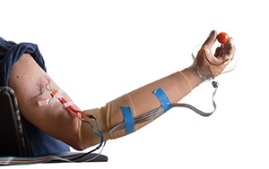Dear Pain Matters blog readers,
Prof. Dr. Christoph Maier and team recently found that restoration of sensation (i.e. tactile performance) in the affected hand via high-frequency repetitive sensory stimulation (HF-rSS) may result in significantly decreased pain in patients with complex regional pain syndrome (CRPS).
Specifically, the Current Pain Intensity decreased by more than 30% in 4 of 16 CRPS patients who underwent HF-rSS of the CRPS-affected hand for 45 minutes a day for 5 consecutive days only.
Significantly improved tactile discrimination in the CRPS-affected hand also occurred in all 16 CRPS patients following HF-rSS intervention.
There were no medication changes in the 16 CRPS patients who had HF-rSS intervention.

Prof. Dr. Christoph Maier
Featured Image and Above Image:
Sources:
http://www.schmerzfreies-krankenhaus.de/kooperationspartner.html
The Study Including Results:
The study involved 20 CRPS patients, 16 who underwent HF-rSS treatment for 45 minutes a day for 5 consecutive days, while another 4 had low-frequency repetitive sensory stimulation.
Targeted electrical stimulation was applied to all the fingertips in the CRPS-affected hand by a custom-made hand pad.
Four (4) of 16 enjoyed significant pain reduction (more than 30% pain reduction) following HF-rSS treatment for 5 consecutive days.
According to Table 1 in the study by Maier and his team, the following 4 patients had significantly reduced pain intensities immediately following HF-rSS treatment for 5 days (compared to their average pain levels, 4 weeks preceding this treatment):
- Patient #2 (46 years, male; CRPS, right hand, duration = 5 months; fracture/surgery)
- Average Pain (prior) = 7
- Current Pain (after) = 0
- Patient #8 (58 years, male; CRPS, left hand, duration = 4 months; surgery)
- Average Pain (prior) = 6
- Current Pain (after) = 1
- Patient #9 (60 years, female; CRPS, left hand, duration = 2 months; fracture/surgery)
- Average Pain (prior) = 10
- Current Pain (after) = 1
- Patient #15 (60 years, male; CRPS, right hand, duration = 8 months; fracture/surgery)
- Average Pain (prior) = 9
- Current Pain (after) = 2
The same Table 1 also listed 2 additional patients with significantly reduced pain following low-frequency repetitive sensory stimulation:
- Patient #19 (58 years, female; CRPS, right hand, duration = 9 months; surgery)
- Average Pain (prior) = 7
- Current Pain (after) = 3
- Patient #20 (58 years, male; CRPS, left hand, duration = 4 months; fracture/surgery)
- Average Pain (prior) = 5
- Current Pain (after) = 0
It is not known how long these pain reductions lasted.
Summary:
High-frequency repetitive sensory stimulation (HF-rSS) to all fingertips in the CRPS-affected hand:
- to improve sensory loss (i.e. restore sensation including tactile performance); and/or
- to reduce pain in the CRPS-affected hand
may be a useful non-pharmacological (add-on) treatment for some CRPS sufferers.
Maier and his colleagues conceded that while CRPS patients were only tested for 5 consecutive days, greater pain reductions for more CRPS patients may have resulted had the testing period been significantly longer.
This is a fair comment given that a study involving 2 amputees with phantom limb pain resulted in restoration of sensation as well as nil phantom limb pain following ‘prosthetic system treatment’ for (up to) 2 years.
Sabina Walker
“Sedare dolorem divinum opus est”
“It is divine to alleviate pain”
Galen, 130-200 C.E.
REFERENCE
(1) David M, Dinse HR, Mainka T, Tegenthoff M, Maier C.
High-Frequency Repetitive Sensory Stimulation as Intervention to Improve Sensory Loss in Patients with Complex Regional Pain Syndrome I.
Frontiers in Neurology. 2015;6:242.
doi:10.3389/fneur.2015.00242.
http://www.ncbi.nlm.nih.gov/pmc/articles/PMC4648023/pdf/fneur-06-00242.pdf
(2) High Frequency Stimulation in Pain Medicine
Kalus, Annegret
Ruhr-University Bochum (No. 163 – 20.11.2015)
http://aktuell.ruhr-uni-bochum.de/pm2015/pm00163.html.en
(3) Hochfrequente Stimulation Hilft Menschen Mit Schmerzsyndrom
Schubert, Christine
CRPS Bayern Morbus Sudeck Selbsthilfegruppe (19.2.2016)

